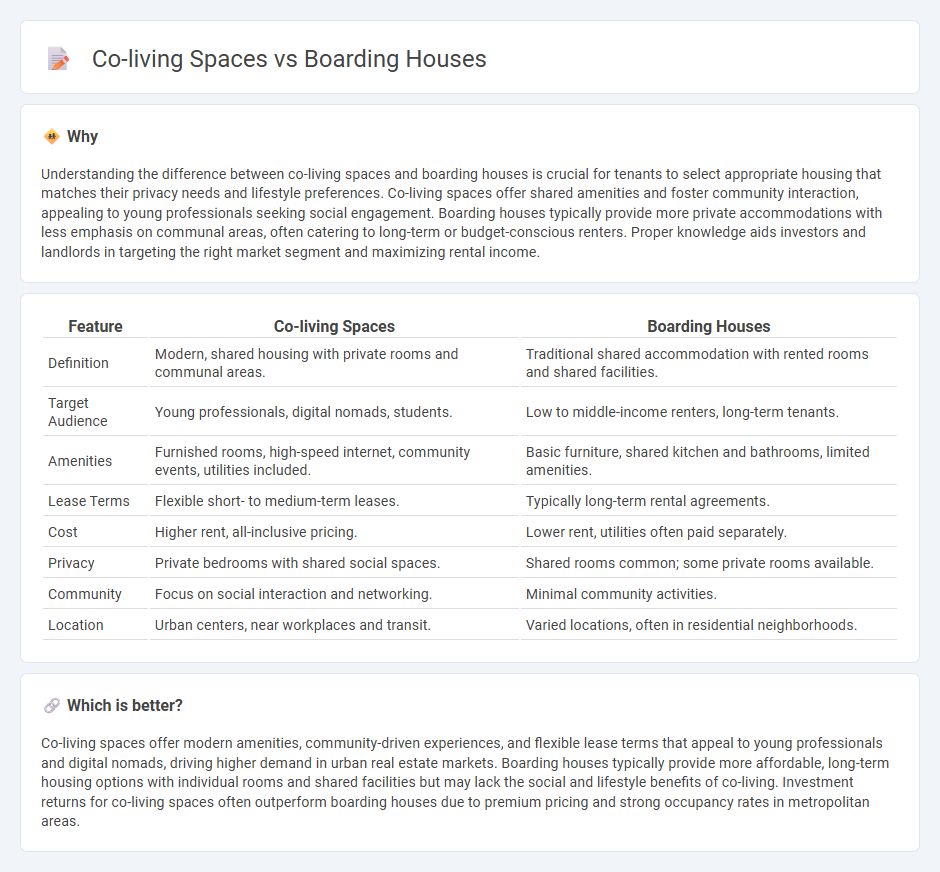
Co-living spaces offer modern, community-focused living arrangements with shared amenities designed for urban professionals, while boarding houses provide more traditional, affordable lodging with private rooms and communal facilities. Real estate investors find co-living appealing due to higher rental yields and flexibility, whereas boarding houses attract long-term tenants seeking budget-friendly housing options. Explore the benefits and distinctions between these housing models to make informed property investment decisions.
Why it is important
Understanding the difference between co-living spaces and boarding houses is crucial for tenants to select appropriate housing that matches their privacy needs and lifestyle preferences. Co-living spaces offer shared amenities and foster community interaction, appealing to young professionals seeking social engagement. Boarding houses typically provide more private accommodations with less emphasis on communal areas, often catering to long-term or budget-conscious renters. Proper knowledge aids investors and landlords in targeting the right market segment and maximizing rental income.
Comparison Table
| Feature | Co-living Spaces | Boarding Houses |
|---|---|---|
| Definition | Modern, shared housing with private rooms and communal areas. | Traditional shared accommodation with rented rooms and shared facilities. |
| Target Audience | Young professionals, digital nomads, students. | Low to middle-income renters, long-term tenants. |
| Amenities | Furnished rooms, high-speed internet, community events, utilities included. | Basic furniture, shared kitchen and bathrooms, limited amenities. |
| Lease Terms | Flexible short- to medium-term leases. | Typically long-term rental agreements. |
| Cost | Higher rent, all-inclusive pricing. | Lower rent, utilities often paid separately. |
| Privacy | Private bedrooms with shared social spaces. | Shared rooms common; some private rooms available. |
| Community | Focus on social interaction and networking. | Minimal community activities. |
| Location | Urban centers, near workplaces and transit. | Varied locations, often in residential neighborhoods. |
Which is better?
Co-living spaces offer modern amenities, community-driven experiences, and flexible lease terms that appeal to young professionals and digital nomads, driving higher demand in urban real estate markets. Boarding houses typically provide more affordable, long-term housing options with individual rooms and shared facilities but may lack the social and lifestyle benefits of co-living. Investment returns for co-living spaces often outperform boarding houses due to premium pricing and strong occupancy rates in metropolitan areas.
Connection
Co-living spaces and boarding houses both address the growing demand for affordable, flexible housing options in urban real estate markets. These models optimize space utilization by offering shared amenities and communal living areas, attracting young professionals and students seeking cost-effective accommodations. Real estate developers leverage co-living and boarding house concepts to enhance occupancy rates and adapt to shifting lifestyle preferences.
Key Terms
Lease Structure
Boarding houses typically operate on short-term leases or weekly rent agreements, providing flexibility but limited tenant rights. Co-living spaces offer more structured lease contracts, often monthly or yearly, with inclusive amenities and community rules promoting longer stays. Explore the distinct lease structures to determine which housing option suits your lifestyle and legal preferences.
Shared Amenities
Boarding houses typically offer basic shared amenities such as communal kitchens and bathrooms, prioritizing affordability and privacy in separate rooms. Co-living spaces provide enhanced shared facilities including coworking areas, fitness centers, and social lounges designed to foster community and collaboration. Explore the distinct benefits of each to find the ideal shared living environment for your lifestyle needs.
Occupancy Regulations
Boarding houses typically face stricter occupancy regulations due to local zoning laws, often limiting the number of tenants per room to ensure safety and compliance. Co-living spaces benefit from more flexible occupancy rules, promoting communal living environments with shared amenities designed for longer-term stays. Discover how these regulations impact your housing options and rights in different regions.
Source and External Links
Boarding House - A house where lodgers rent rooms, often with shared facilities, sometimes including meals, and the landlord retains access rights.
Boarding House Regulations - Provides information on local regulations and licensing requirements for operating boarding houses in Ohio.
Boarding Room in Cleveland - Offers a fully furnished room within an apartment building with utilities included, located in the S. Collinwood neighborhood.
 dowidth.com
dowidth.com